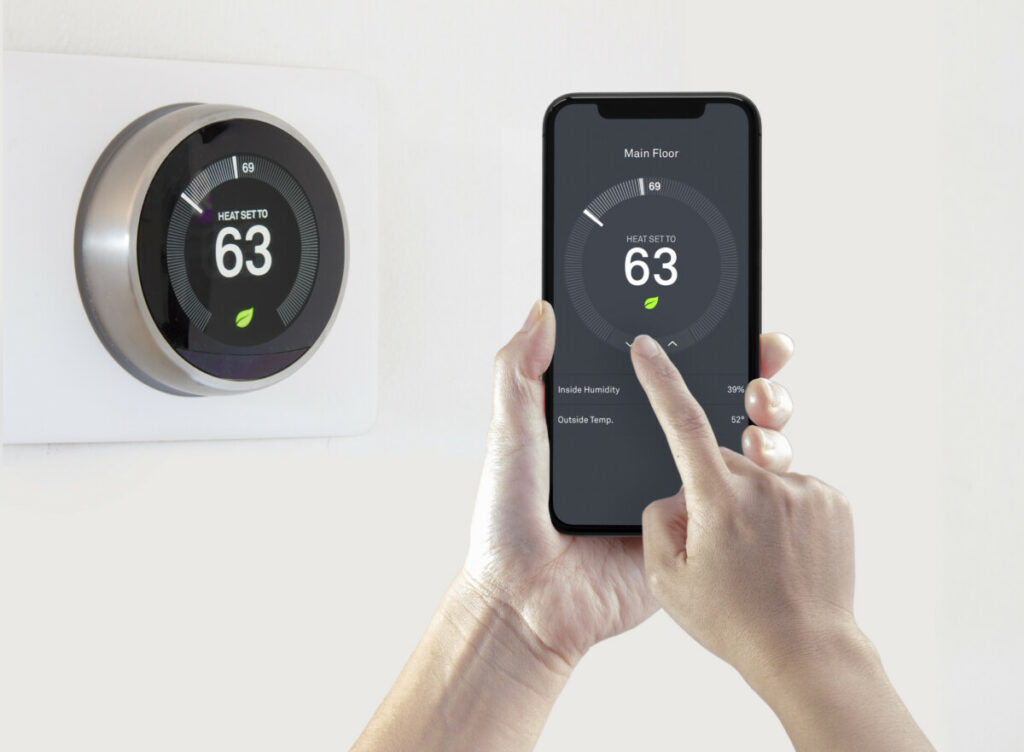- Making the Most of Your Smart Home: Common Use Cases - March 28, 2023
- Eco Mode at Night: Maximizing Nest’s Energy Savings - March 20, 2023
- Connecting & Controlling Smart Home Devices: A Guide - March 18, 2023
Disclosure: Links marked with * are Affiliate Links. As an Amazon Associate, I earn from qualifying purchases if you decide to make a purchase through these links – at no cost for you!

Homes today are getting smarter and more technology-based. Smart security systems make it possible for you to lock your front door from across the world and smart doorbells allow you to see and communicate with visitors if you are away, or turn off your lights with the press of a button! One of the newer smart home devices is a smart thermostat that works in multiple zones.
The best smart thermostat for multiple zones currently on the market is the Nest Third Generation Learning Thermostat*. It is different from other thermostats available because users can set the zones to be different temperatures. This thermostat also learns and adjusts to users’ behaviors.
Going forward, we’ll talk more about the features the Nest Learning thermostat has that make it the best. If this thermostat wouldn’t work well in your home for some reason, don’t worry! We’ve got you covered by giving you some more options in this article, as well as talking about what you need to know before purchasing a smart thermostat for multiple zones.
Table of Contents
Why the Nest Learning Thermostat is the Best
Check Price:
Nest is one of the best brands out there for smart home devices. They carry everything from speakers, to security devices, to gaming systems. Their smart thermostats are some of the most highly rated ones currently on the market, with the Nest Third Generation Learning Smart Thermostat* being one of their best sellers.
Because Nest has so many other smart home devices, it is easy to add a smart thermostat to the hub and have everything in your home connected.
The Nest Learning thermostat has ten different sensors that monitor aspects such as ambient light, humidity, and motion. Its Farsight technology helps the thermostat sense when someone is in a room.
As you use the thermostat more, it will collect data concerning your habits. With this data, the Nest thermostat will adjust to your behaviors, turning the heat or air conditioning on when you get home from work and turning it off when you leave the house.
The only downside to this is that the system doesn’t turn to start heating or cooling until you are inside the house, meaning you could have to wait five or ten minutes before it gets to a more comfortable temperature.
To get around this issue, you can set up a schedule manually so that your home will be exactly how you want it when you are there.
Now the main reason that the Nest Learning thermostat is the best for multiple zones is that you can set the thermostat to a different temperature in different zones. This feature isn’t possible on many multiple-zone smart thermostats.
However, in order for the thermostat to register temperatures in other zones, you will have to buy temperature sensors* for each zone.
Other Smart Thermostat Options
While the Nest Learning thermostat is the best option for multiple zones, you may be looking for something a little different. If that is the case, keep reading to get familiar with some other smart thermostats on the market that may be a better fit for you and your home.
Ecobee 4
Check Price:
The Ecobee 4* is another great option for a smart thermostat that works in multiple zones. Unlike the Nest Learning thermostat, the Ecobee 4 comes with one sensor that you can put in another zone which cuts down the cost a bit.
Although this system can sense the temperatures in separate rooms or zones, all the zones are set to the same temperature automatically.
One fun feature that the Ecobee 4 has is that it has Alexa built-in. This means that not only can you change the temperature through your phone while you are away, but you can control it by voice command while you’re home. However, users have complained that if you turn off Alexa, a red light will continually flash, which can become annoying.
The main reason that many people opt to buy and install smart thermostats is to conserve energy. The Ecobee 4 helps users do that by automatically powering off when no one is home. The system also gives a monthly report or update on your home’s energy consumption and how you could change small things to conserve even more energy.
This device is also Energy Star certified, meaning it lives up to the strict energy efficiency standards set by the US Environmental Protection Agency.

Honeywell Lyric T5
Check Price:
The Honeywell Lyric T5 Smart Thermostat* is one of the more budget-friendly options for a smart thermostat. This thermostat is not as high-tech as the others we have discussed so far, but it still gets the job done.
Using a technology called geofencing, the system can tell whether or not someone is home based on whether or not it can discover their phone. To split the house into zones, you will need to buy sensors.
Like the other smart thermostats, the Honeywell Lyric turns off the heat or air conditioning when it can no longer sense that anyone is at home, but it doesn’t memorize your schedules or habits.
In addition, users can set up their own schedules manually to decide when they would like the HVAC to be running. You can control the temperature settings through the touchscreen on the thermostat or through your smartphone.
Something unique about the Honeywell Lyric is that it calculates and reports how much time it takes to get the room up or down to temperature. It also sends alerts to notify you of any extreme temperatures or to change the air filter.
The main drawback of this device is that it is not compatible with most Wi-Fi settings. Before purchasing this device you will need to make sure it will work with the Wi-Fi you already have set up in your home.
Emerson Sensi
Check Price:
The Emerson Sensi* is another popular and even award-winning choice in smart thermostats. This device is Energy Star certified and is compatible with many smart home systems such as Amazon Alexa, Google Assistant, Apple HomeKit, and SmartThings.
Like the Ecobee 4, the Emerson Sensi uses Geofencing technology to sense if someone is home and know whether or not it should turn off the heat or air conditioning.
The only problem with this technology is that it bases this information on your phone location so if you leave your phone in one room, then it will heat and cool that zone instead of the one you are actually in.
The Emerson Sensi isn’t the most aesthetically pleasing smart thermostat on the market right now. It has a simple but basic interface and comes in black, white, and silver.
The Emerson Sensi is a more economical option. The device measures temperature and humidity and will send you an alert or notification if the temperature or humidity level gets alarmingly high or low.
Before purchasing an Emerson Sensi smart thermostat, you will need to check to make sure that it is compatible with your home system and router, as this device doesn’t support IFTTT.
One plus is that it is relatively easy to install. The Emerson Sensi thermostat uses regular wiring instead of the c-wiring that most smart thermostats use, making the installation process go a little more smoothly.
GLAS Smart Thermostat
Check Price:
The GLAS Smart Thermostat* was actually created by the company that invented the thermostat – Johnson Controls. With a name like that backing it up, you know it must be a quality product. The GLAS smart thermostat system has a sleek, smooth, and stylish interface. This device is the most expensive smart thermostat we’ve discussed.
That being said, there is a reason for its high pricing. The thermostat system has a super user-friendly interface and can be controlled entirely from the screen.
Unlike other smart thermostats that only adjust to when people are in the home, the GLAS smart thermostat also adjusts heating and cooling to your sleep schedule as well.
The GLAS smart thermostat also has an air quality control sensor. This sensor lets you know if there is too much carbon monoxide in the air or if the air quality is alarmingly low. Although it can’t do anything to fix the problem, being aware could save your and your family’s lives.

What you Need to Know Before Purchasing a Smart Thermostat for Multiple Zones
Room Sensors
There are quite a few factors that go into making a smart thermostat that works well for multiple zones. The main factor is room sensors.
Many people assume that since you bought the smart thermostat that it will be ready to go in multiple rooms. This, however, is not the case. You will need to put sensors in other zones so that the main thermostat will be able to have access to the temperature in those other rooms.
ENERGY Consumption
One of the main reasons that people invest in smart thermostats, other than convenience is that it is just one way that they can reduce their energy consumption. This is better for the environment and saves you money on your energy bill as well.
The best way to make sure that your smart thermostat will actually have those benefits is to choose one that is Energy Star certified. If a product is Energy Star certified it lives up to higher standards.
Smart Device Compatability
Another important feature is the smart thermostats’ smart device compatibility. Almost all smart thermostats connect to smartphones, but only select ones can be controlled through voice command through technology such as Amazon’s Alexa, Apple’s Siri, or Google Assistant.
Looks & Aesthetic
Since a smart thermostat becomes a semi-permanent fixture in your home, it is essential to pick one that fits your aesthetic. Smart thermostats that function in multiple zones come in a variety of shapes, designs, and colors.
Most commonly, they come in the form of a small, circular touch screen. Others that have a more interactive interface are a bit larger and rectangular-shaped. Smart thermostats also come in a variety of colors and finishes so that you can pick the one that goes best with your current home decor.
Ease of Installation
The ease of installation is another thing to consider. Most smart thermostats can be installed easily by the user, but others may require the assistance of a professional.
Many smart thermostats also need special wires called c-wiring that are a little more tricky to install than it would be to just connect the device to the existing wires.
Benefits of Having a Smart Thermostat for Multiple Zones
Now after reading all of that, you may be wondering, is a smart thermostat that functions in multiple zones really worth it? Will it really reduce my energy bills and create a more comfortable home environment? Well, I’m here to tell you that yes, it will for sure.
To start, having a smart thermostat is much more convenient than your traditional, run-of-the-mill thermostat. For example, if you are already in bed for the night but forgot to turn off the air conditioning, you can turn it down by grabbing your phone instead of running downstairs to turn it off manually.
You can also control the thermostat from anywhere you are with a Wi-fi connection. If you are driving home from work in the hot traffic of summer, you can at least know that you will be able to cool down in your house because you turned the air conditioning on before you left the office.
Believe it or not, having a smart thermostat that can change the temperature in multiple zones may result in fewer conflicts at your house as well.
I always remember my parents disagreeing about how hot we should keep the house. My mom is always cold and my dad hates spending money by turning on the heat when we have a wood-burning fireplace.
With multiple zones, you can make the office where dad works colder and the master room where mom spends more time a little warmer without having to worry about racking up a huge energy bill.
Attention: When installing electronic equipment, please be sure to observe the manufacturer’s safety instructions. You have to take care of your own safety. The information on this site only helps you to learn.
Disclosure: This website is the property of Martin Lütkemeyer and is operated by Martin Lütkemeyer. Martin Lütkemeyer is a member of the Amazon Services LLC Affiliate Program, an affiliate advertising program designed to enable Web sites to earn advertising revenue through advertising and linking to Amazon.com. Links marked with * are affiliate links.





